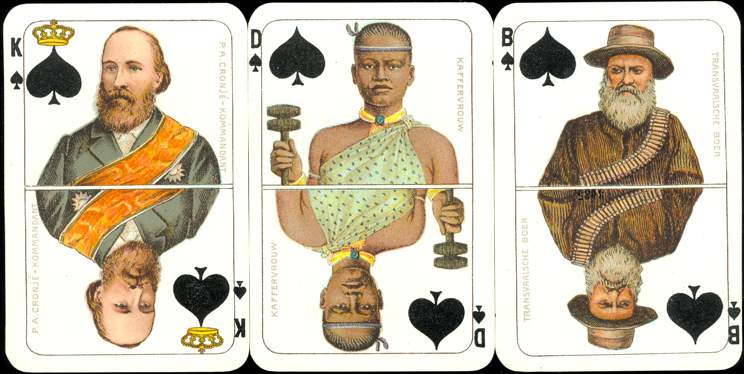
July 2011
The deck arrived on the 1st of July and we already knew then, that it would require an exceptional find to surpass this one as Deck of the Month. And we didn't find such a deck, but we have tried....... Due to the rainy weather only a few outdoor markets were visited, but we roamed around on various auction sites and we did an exchange of 10 decks with a Russian collector. So there was enough competition, but it just wasn't in the same league.
This month's deck came from the American Ebay.
We often
refer to this site as the international Ebay and this time it functioned as such, as
we bought it from a Dutch seller. It was advertised as a lot of 1000+ cards and
held about 12 decks and a lot of single cards. The pictures showed only the
whole lot and by studying them, we found that there were some good decks (to
resell) among them and one interesting box that was shown in between a stack of
cards. The content wasn't shown, but it had the name of C.L. Wüst on one of the
sides. We asked the seller some questions about the decks, but he answered that
they were already packed. We put in a bid anyway and were surprised to win the
whole lot for a mere $ 34. When the package arrived the interesting decks turned
out to be complete, but when the Wüst box turned up we were amazed and
excited. The box was in excellent
condition and when we saw the front of the box, we immediately knew that, if it
had the correct content, we could strike another deck from our wish list. So we
quickly opened the box and found our long sought deck and............ in near mint
condition, with shiny gold corners! So this time we're extra proud, that we're able
to share this beautiful and rare Deck of the Month with you. ENJOY!

The deck was made by
C.L. Wüst from Frankfurt and published as "Transvaalkaart" in 1903,
about a year after the Second Boer War (1899 - 1902) had ended in a victory for
the British troops.
It was printed in fine chromolithography and the courts show Boer leaders, women
from indigenous tribes and soldiers from the Orange Free State and Transvaal,
the Boer name for what the British referred to as the South African Republic. It
is obviously a pro-Boer deck, so it's no surprise that it was published in the
Netherlands, as the Boer society was originally for the larger part of Dutch decent. The word "boer"
means farmer in Dutch and that's exactly what they originally were: Dutch
farmers, seeking a better life in the Southern part of Africa.
But there's one oddity, that immediately catches the eye: the crowns on the
Kings, usually a reference to royalty, are placed here next to the heads of
presidents and commanders, who had just lost a war. It was probably done as a
royal gesture in acknowledgment of their brave resistance against the British
troops.
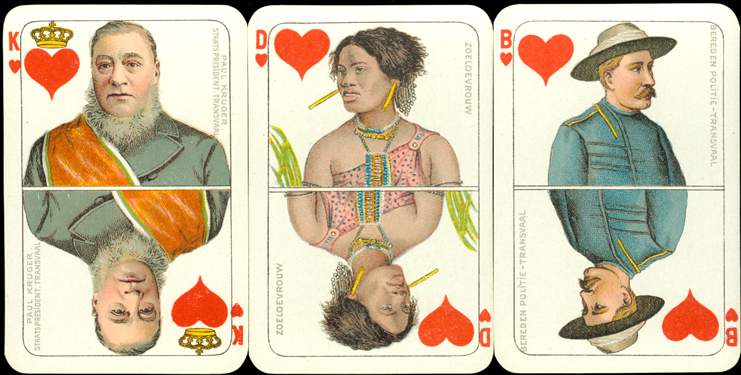
The King of Hearts shows Paul Kruger, by far the most important representative of the Boer interests and President of Transvaal. He was elected for the first time in December 1880, not long after the outbreak of the First Boer War, and in 1898 for the fourth and last time. After the First Boer War was won by the Boer army in January 1881 and settled in an agreement in March of that year, in which the two young republics regained their self-government and independence, although under a restrictions. Kruger visited England in 1883 to negotiate a better agreement. On that same journey he visited the Netherlands, Belgium, France, Spain and Germany, where he was received by the Emperor, Wilhelm I.
But things were quite different in 1900, when Kruger was forced to flee from
Pretoria by the approaching English troops. Although Queen Wilhelmina of the
Netherlands had send a warship to rescue him, once in Europe the German Emperor
refused to see him. He lived in the Netherlands in rented houses until October
1902, when he moved to Menton, France.
Interesting in connection with this deck is the fact that he returned from
Menton to the Netherlands from May 1903 until October 1903. Of course there's no
hard evidence, but the publication of this deck could have been one of the
issues that brought him back to the Netherlands that year.
The aces show scenes from the war and presidential houses, government buildings from Transvaal and the Orange Free State.
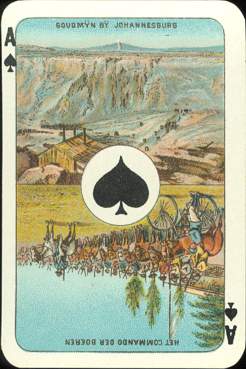
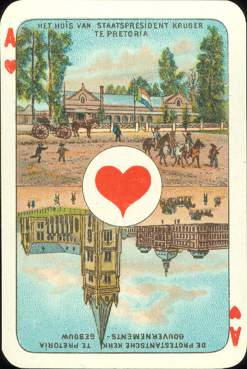
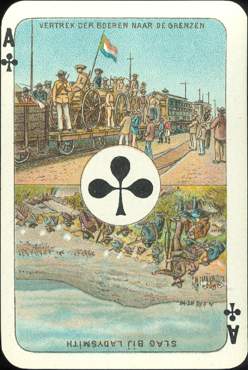
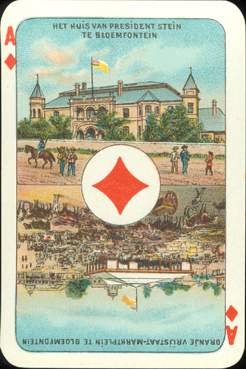
On the Ace of Spades a goldmine near Johannesburg is depicted. It was General Joubert (King of Clubs) who already predicted in the mid 1880's that the discovery of gold would in the end lead to the fall of the Republic and......... it did. The gold rush led to an enormous inflow of "uitlanders" ("foreigners", here non-Boer whites), which had vast political repercussions, and taxing the dynamite that was needed in large quantities for extraction, didn't amuse the British either. But when president Kruger gave the monopoly of manufacturing the explosives to a non-British company, this became a major pretext for the Second Boer War.
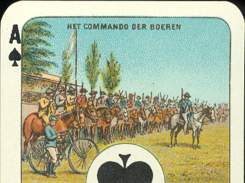
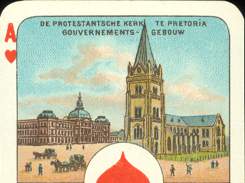
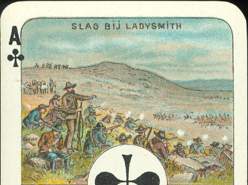
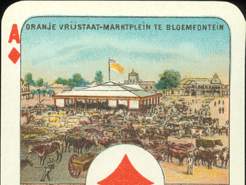
On the Ace of Clubs the Battle of Ladysmith is depicted. It shows to the victorious start of the siege of the garrison town Ladysmith. The Boer armies were surrounding the town and on 30 October 1899 a sortie was launched, which ended in a disaster for the British army. The Boer general Joubert didn't want to press on and this lead to a siege of the town that lasted 118 days.
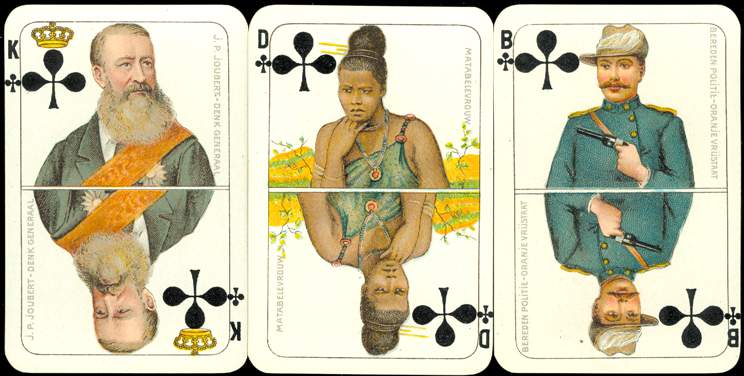
Each of the Kings
is wearing a sash, but as far as we know, only the presidents were entitled to
wear one. However, maybe General J.P. Joubert (Clubs) and Commander P. A.
Cronjé (Spades) were entitled to wear a sash too. At least the presidents are
recognizable by the white rim of their sash.
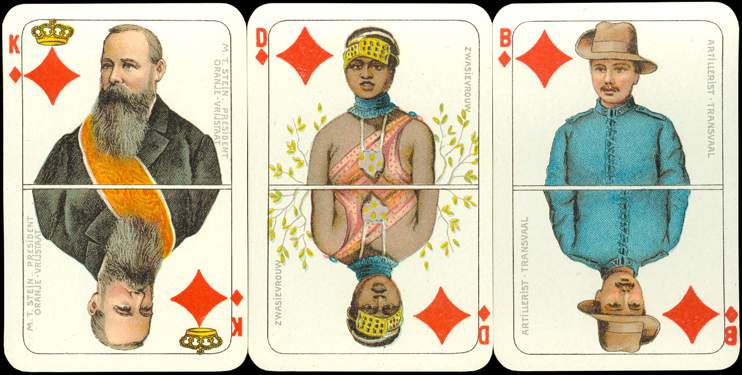
The back design
shows the maker's name in the border. The center shows the coat of arms of the
Transvaal republic.
"Eenheid maakt macht" (Unity creates power) was their motto.
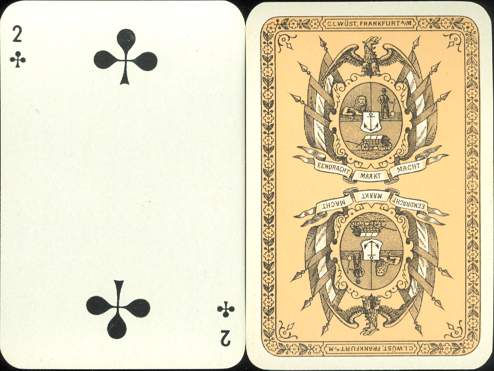
Front of the box shows Paul Kruger and the Transvaal coat of arms, the back an allegoric scene, in which a Boer is holding the Transvaal flag.
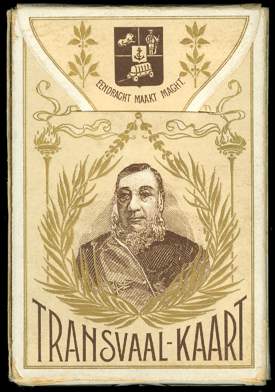 |
|
|
There's another deck on xpo, which was published in 1900, just before president Kruger was helped to escape from South Africa by the Dutch Queen. The fact that two separate decks, dedicated to the Boer cause, were published in the Netherlands is illustrative for the interest that the Dutch had in the well-being of their former countrymen. Both decks were probably published to raise political support for the Boer cause. Interested to see the other deck? It's only a CLICK away.